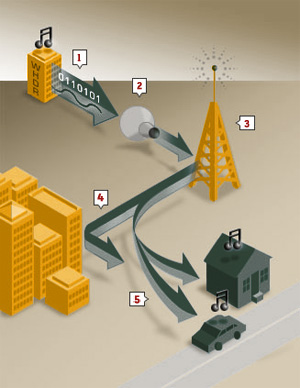
HD movies, HD TV, HD audio, and now we have HD radio.
There is a new radio technology around the corner. Its called HD radio. Despite the fact that it has nothing to do with the High definition (HD) term used in HDTV, HD movies and HD audio, it is definitely better than our old school radio technology and delivers CD quality sound over FM and FM quality sound over AM.
According to wikipedia:
HD Radio technology is a system used by AM and FM radio stations to digitally transmit audio and data in conjunction with their analog signals. This system enables AM and FM radio stations to simulcast both digital and analog audio within the same channel (a hybridized digital-analog signal) as well as add new FM channels and text information. Although HD Radio broadcasting’s content is subscription-free, listeners must purchase new receivers in order to receive the digital portion of the signal.
According to hdradio.com:
It’s the most significant advancement in radio broadcasting since the introduction of FM stereo more than 50 years ago. HD Radio technology enables AM and FM radio stations to broadcast their programs digitally – a tremendous technological leap from the analog broadcasts of the past.
Work on the HD radio technology started way back in 2001 when satellite radio came into the arena offering much more stations, CD quality sound, strong reception everywhere and channels without any commercials at all.
How it works:

Basically, digital radio works the same as conventional radio. There’s a signal on one end and a receiver on the other. But there are a few key differences.
[1] Instead of sending out one analog signal, stations send out a bundled signal – both analog and digital. Because it is digital, textual data such as traffic, stock info and song titles can be sent out, as well.
[2] The digital signal layer is compressed.
[3] The combined analog and digital signals are transmitted.
[4] Inevitably, radio signals bounce off objects, causing what is called multipath distortions. This is what causes the static in conventional radio receivers. HD Digital radio receivers are designed to sort through reflected signals, reducing static, hiss, pops and fades.
[5] Finally, the signals reach their destination. Both broadcasts are free, with no subscription fee. To hear the digital broadcast, all you need is an HD Radio receiver.
HD Radio offers a lot of advantages over conventional radio:
- Digital signals ensuring much better audio quality
- Multiplexing of analog and digital signals for backward compatibility with old radio receivers
- Shadow channels on the same frequency
- Free!
Apparently, HD radio is not gaining much popularity due to a number of reasons:
- You need a new receiver. No matter how much the quality improvement be, it is very difficult to convince people to invest in a new device
- Clumsy controls. You will need to tackle a lot of buttons to take full advantage of features such as shadow channels
- People get confused with so many options at their disposal. Standard radio, Satellite radio and now HD radio.
- Lack of quality content
HD radio is slowly gainig popularity in the US. There are more than a thousand radio stations broadcasting in HD radio and over a hundred receiver models available. Many cars also come with HD radio compatible music systems.
It will take some time for HD radio technology to come to countries like India where there are a lot of barriers to entry for new technology. Till then, we have the option of satellite radio which, despite based on a subscription based model, is gaining popularity here owing to better content and audio quality.
[Via NYTimes]
[Portions from wikipedia, hdradio.com]



